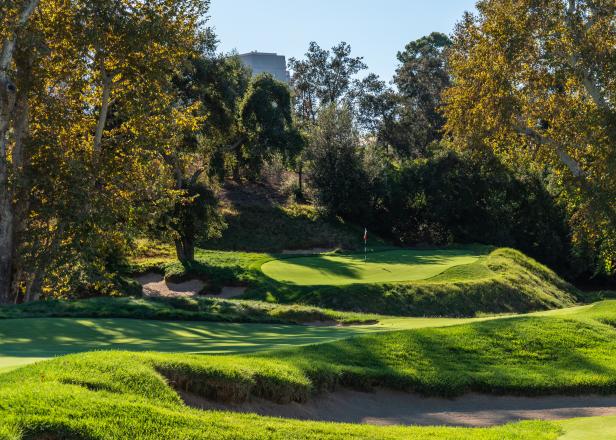LOS ANGELES — The story goes that on a visit to Los Angeles County Club years ago, Ben Crenshaw was playing the North Course’s 17th hole, and then wandered over to the thick growth of brush and trees to the right of the fairway. Like an explorer who had heard rumors of long-lost treasure, he pulled away the branches and peered into the darkness.
“Here is this two-time Masters champion, pushing through the brush,” says Geoff Shackelford, his face lighting up to match the wonderment of the tale. “But that speaks to how iconic it was.”
“It” was a mysterious golf hole whose lore was spread over 90 years. Shackelford, a golf writer and historian, whose research was instrumental in the North Course’s restoration in the 2010s by Gil Hanse and Jim Wagner, is a popular witness this week about all things LACC as the club hosts its first U.S. Open.
Dubbed “Little 17,” the par 3 was part of the LACC layout designed by W. Herbert Fowler in the early 1920s. With a small, severely sloped green from back to front, it could be ornerous, and its infamy grew in the 1925 California State Open played at LACC when a Santa Ana wind blew, and players found it impossible to hit the green. The event’s winner, Macdonald Smith, heroically managed to “only” bogey the hole.
A year later, the first Los Angeles Open was staged at LACC, and Shackleford said much of the pre-tournament chatter was about how difficult the 17th might play.
But, ultimately, when George C. Thomas performed a significant overhaul of the North Course in the late 1920s, “Little 17” had to go. It simply didn’t figure in Thomas’ vision, and he created an entirely new par 3, the 11th, which is now the course’s most recognizable hole.
Curiously, however, the green at “Little 17” green was not destroyed, but simply allowed to be overgrown to the point where, decades later, it was invisible to golfers playing down the new par-4 17th.
During LACC’s committee talks about the restoration, Shackelford recalled that it was jokingly mentioned that a resurrection of “Little 17” could be done. That idea stewed with the committee for a while, until one day, Shackelford said, Hanse’s team was told it would be building 20 greens—the additions being “Little 17” and a re-establishment of the second green after Hanse chose to move the No. 2 green to the left of the existing green. (That decision was controversial, and for a time, some members of the club played to the old second, though it was eventually abandoned and now is used as a practice area.)
Hanse and Co. were excited to do the work, because not only would the members have a unique hole to play, but it would carry on Thomas’ desire to create “loops.” In this case, golfers could go out in the afternoon and play the first hole, “Little 17” and 18th hole. It’s said that has been done as a derby before the club’s member-guest, and the hole is available much of the time. “Little 17” plays at 120 yards from a flat spot created near the No. 2 tee.
“It was fun for us,” Shackelford said. “It was a way to pay homage to the old course, and it didn’t take anything away from the big [17th] hole.”
Mike Davis, the USGA’s CEO and setup man at the time of the 2017 Walker Cup at LACC, loved “Little 17” so much that he considered using it for a round during the matches. But, Shackelford said, it was decided that because the hole would have to sub for another short par 3, the 15th, that that just wasn’t doable because the 15th was deemed to be too good.
On Tuesday, “Little 17” got plenty of attention and TV airtime because players were encouraged to play it as part of a charity event. The day before, Shackelford said he was walking with Rory McIlroy during his first practice round when coach Brad Faxon pointed over to the gorgeous hole. “Whoa!” McIlroy said, stunned by the hidden gem.
This time, a major champion didn’t have to go hunting for it.
